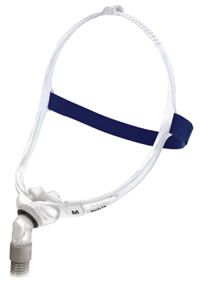Product Premier
A Design on Comfort
New nasal pillow system aims to increase patient ease of use in order to drive treatment compliance.
- By David Kopf
- Feb 12, 2010

ResMed Inc.’s new Swift FX combines
silicon headgear and low-profile backstrap
with gentle-fit nasal pillows to offer up a
combination of comfort and unobtrusive
looks to ensure patient use.
The most challenging element involved with treating sleep patients is compliance. It’s not that they don’t necessarily want to comply with treatment, it’s that they have a difficult time pulling it off because it’s simply not natural or comfortable to sleep while wearing a device. Moreover, many face a psychological barrier in getting used to the notion that they need a device simply to sleep.
So the goal for manufacturers of sleep systems is to come up with the most comfortable, unobtrusive device they can, while still delivering the necessary treatment. In an ideal world, the goal is to come up with something that the patient forgets is even there.
This was the exact goal in mind when ResMed Inc. began developing its Swift FX nasal pillows system, which debuts this month.
Focusing on Feedback
Like many good DME ideas, the genesis of the Swift FX came from the patients, according to Greg Peake, product manager for ResMed’s masks. According to Peake, Design of the Swift FX came after meeting with clinicians and patients to see how ResMed could continue its successful run with its Swift LT, and the feedback the company received was that they wanted even more comfort.
Given that the device is something that patients have to sleep with, they said they wanted the whole unit to be soft and flexible and to have minimal hard pieces and be even easier to use, he says.
“And then from clinicians, they said ‘I want things to be faster to fit; higher patient acceptance; and to get patients satisfied and comfortable and set up quickly so that I can process more patients in one day,’” he says.
A secondary point that ResMed received from patients was that they didn’t like the way they looked in masks. “They said, ‘Ideally, I’d like an invisible mask. Why can’t I have an invisible mask,” he explains, adding that patients asked if they could have something analogous to a nasal cannula.
While there are some understandable reasons such as pneumatics and airflow that explain why something like a cannula isn’t feasible, the overall notion of reducing the physical and psychological barriers that hurt compliance rates and prevent patients for getting and maintaining therapy, Peake says.
“Functionally, it has to do the job, and above and beyond that, how can we return you to the most natural and normal way of sleeping both in terms of pure functionality, but also in terms of how you look with the product and self image,” he explains.
Key Features
One of the main features that ensures the Swift FX ensures patient comfort is a new silicon headgear, which lets the system hug very closely to the patient’s face. Much of the problem was the use of rigid structures.
“In previous pillow products we’ve had and with other CPAP masks in general, a lot of people find that during during normal sleep movement they will bump the mask or the mask will catch on pillows or bed sheets and knock out of place, which leads them to over-tighten things,” Peake explains. “Because the shape of the Swift FX is so streamlined and the whole thing is flexible it can adapt to different sized faces and different facial geometries and really keep things nice and tight so there’s nothing really to bump against. In the trials we’ve done, patients have said they have a greater range of sleeping position.”
The silicon headgear also lets the patient’s skin breathe and not get hot or sticky, which could also impact compliance. Also, because the silicon headgear hugs the face so well, patients don’t have to strap it down tight to ensure a good fit. This translates into even more comfort, and thusly compliance.
For the pillows, dual-wall pillows and a flexible cushion base maintain a good seal while adapting to any patient movement that might occur during the night.
The strap takes a similar approach as the silicon headgear. Instead of a buckle at the back, there is a hook-and-loop connection. Likewise, at the top of the headgear, there is minimalist top buckle that interfaces with little bumps along the headgear’s top edge. The result is often a one-time setup for patients, with no night-to-night adjustment.
“A lot of patients say ‘My clinician set this up for me, and then after that I’m just slipping it on and off every night, but it stays put during sleep,” Peake says.
ResMed Inc.
(800) 424-0737
www.resmed.com
This article originally appeared in the February 2010 issue of HME Business.
About the Author
David Kopf is the Publisher HME Business, DME Pharmacy and Mobility Management magazines. He was Executive Editor of HME Business and DME Pharmacy from 2008 to 2023. Follow him on LinkedIn at linkedin.com/in/dkopf/ and on Twitter at @postacutenews.